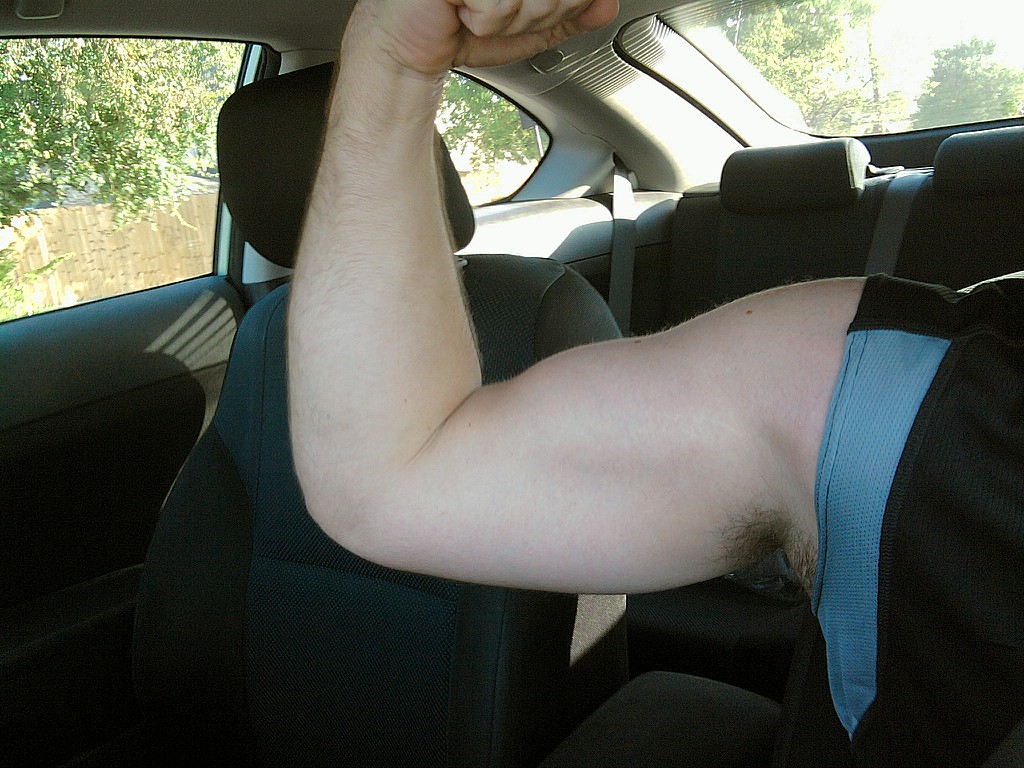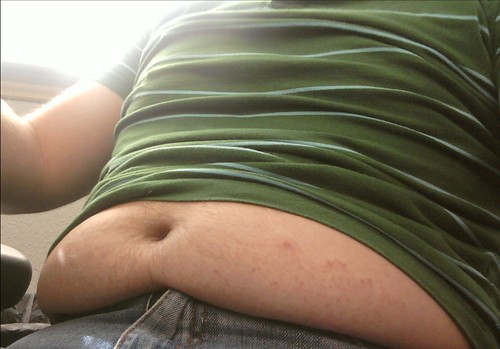
I went to spin class after work yesterday and worked up a good sweat.
I had an awesome HIIT this morning did 24 minutes instead of the usual 20.
http://www.mapmyrun.com/routes/view/43511966
Daily journal of fitness, nutrition, workouts, and rants.

By soni2006
Law of Overcompensation
Law of overcompensation is also referred to as law of super-compensation. According to me, this law explains why weight and resistance training works. A muscle grows in response to heavy resistance training is that the body is stressed by this type of training. Lacerated tissue develops scar tissue. The body always seeks to minimize stress. One way to do this is to increase a muscle’s ability to handle a particular load by increasing its size and ability to meet it. The result of this process is that if the next time original load is encountered by the muscle, the load will feel lighter and the body is happy. It is nothing more than a survival mechanism built into the genetic code of a person.
Overload Law of Weight Training
This follows the overcompensation law. It is obvious that in order for over and super-compensation to occur repeatedly, greater stresses must be encountered in a progressively increasing manner, once a muscle has overcompensated, a new, higher stress than the one responsible for the original growth must be introduced to force the process to repeat. There are basically two general ways to increase stress during training and those are either by increasing the volume encountered (the total amount of work performed) or by increasing the intensity of the applied stress.
Law of Individual Differences:
It means that everyone is unique due to genetic differences, and, therefore, will respond differently to similar training stimuli. There is nothing as a “magic program” that will provide the best gains for everyone. Though any particular training method will elicit similar responses in any individual, the magnitude, rate, and other characteristics of that response will vary greatly among the population. This fact makes it essential for a training system to allow for individualization of the prescribed method of a program to allow for such things as different recovery rates, tolerances to exercise, fiber compositions, etc. In addition, this law implies that some training methods may benefit some individuals to a greater degree than others. This is why it does not make sense to copy the program of someone else just because it works for them.
Law of Specific Adaptation to Imposed Demands
Also called SAID, a specific type of stress applied dictates the specific adaptation that will occur. If you train for endurance by using light weights and high reps, you will primarily increase your endurance, not your strength and vice versa. Further, since the body’s recovery ability is limited, training for two types of objectives will detract from the effectiveness of one another. That’s why when someone tells you that their program will increase muscle, endurance, and speed all at the same time, you can laugh at them. The SAID principle means that we train for specific goals during specific periods of time before moving on to other desired objectives. The trick is to train those objectives first that enhance the effectiveness of future training method and to include just enough of the earlier method to avoid losing the benefits we just acquired. It also means that if a particular type of growth or strength is desired we must train in a manner specific to targeting that type of growth or strength.
General Adaptation Syndrome Law
Our body’s response to any type of stress has both similar characteristics and unique characteristics based on the type of stress, but most importantly, the ultimate eresponse comes in 3 stages:
Since all stress produces similar responses in the body as all other types of stress, multiple stresses reduce the body’s ability to adapt to any one stress like muscular gains. Due to weight training, we will be hindered by stress caused from work-related difficulties. If stress repeatedly continues before adaptation can occur, exhaustion sets in as the body is unable to cope with the stresses applied. Therefore, training sessions must be scheduled in such a way that cumulative fatigue is not able to be build up to a point leading to exhaustion. There must be a period of low intensity training or complete rest following periods of high intensity training.
Law of Use and Disuse
Continually applied stresses result in continued adaptation while the termination of applied stress results in atrophy. In other words use it or lose it. It is pretty obvious that if you train you will make progress, and if you do not train, you will become a fat person. However, it takes a lot less time to notice the effects of disuse than it does to reap the benefits of training. In as little as two weeks, you can lose as much muscle as it took you 4 or 6 weeks to gain. Luckily, there does appear to be a counter principle in effect. Once having gained muscle and strength, and then losing it through inactivity, it is possible to reach your past levels of growth in a shorter amount of time than it took the first time around.


Arm Supersets:
Barbell Superset
Stand Barbell Curl
Close-Grip Bench Press
4 Sets of 6 reps
90 seconds of rest
Dumbbell Superset
Lying Dumbell Extension (Skull Crushers)
Hammer Curls
4 Sets of 10 Reps
60 seconds of rest
Cable Superset
Cable Bar Curl
Rope Pulldowns
4 sets of 25 reps
30 seconds of rest
 https://plus.google.com
https://plus.google.com 6-ckd-cyclical-ketogenic-diet.html
6-ckd-cyclical-ketogenic-diet.html
I found out last night that I can use the gym by my parents house. It opens up a whole new world of opportunity for me. I had a great UBWO last night. I pushed hard and hit my 9.5/10s on most of my muscle groups. I hit the sack early last night and got up at 5am. I went for my second ever outdoor HIIT and ended up with 2.1 mi in 20 minutes. It is pretty warm in the dark and all I packed were black clothes. I did something I have never done before, ran without a shirt on. There were no humans around but it felt good. I got to work 30 minutes early and plan to work an 11 hour day.
http://www.mapmyrun.com/routes/view/43182638/
My friend is trying to get me to do a Tough Mudder in March. Any thoughts?

5 days in a row of exercise! I am feeling really good right now. Just took my first sip of coffee for the day after being awake for 2 hours. I am going to attempt a morning HIIT before work tomorrow because we are having a friend over for dinner that evening. Last night Ellen and I headed to the gym for an UBWO. The free weight area was pretty crowded so I used machines for chest, shoulders, and back. I convinced her to join me in the free weight area for biceps and triceps as it was thinning out. I did barbell preacher curls in a slow controlled motion and I am about 5-10 pounds below where I was at the end of my last challenge. Then we did tricep pulldowns with rope attachments. I ended up setting a new 6-rep PR for back and triceps.
Tongiht I am hoping to go to Yoga. My back is hurting when I get home from work after my hour long commute. I have only gone to Yoga once in the past three months. I was going weekly from November until April. I am going to have to make yoga a weekly habit again when I start training for a half marathon begging in August.Great Morning,
I slept in a little but I got to work at a reasonable time. Last night I got on the treadmill but felt the urge to do something new. I did a 2 minute warmup then attempted to do TABATA sprints (20 secs ON 10 secs OFF) for 4 minutes. It takes a while for the speed to change (6mph to 9mph) on the machine (5 seconds) so I did my best despite the limitation. After the 4 minutes I did a 1 minute break then another 4 minutes of sprints. I had 7 minutes left so I did modified BFL HIIT for the rest of the workout. I ended up with 2.22 mi in 20 minutes. Tonight will be UBWO night!
Happy Monday! I had a great weekend visiting the new in-laws. We ate 90% paleo (except for when we got back into town last night) and I have exercised the past 3 days. I have been planning another group challenge with Legs that will start when she gets back August 8th. Let me know if you want to join us. It will be called the BFLUNWFASC: Body for Life United Nations of Workout Freaks All-Star Challenge.
Since people are sharing their doggies here is my dog in-law (JK he is a dog now too). Winston




I have tons on my mind and alot of energy today. I took my blood pressure before my morning coffee and it was 132/83 and a pulse of 59. I have noticed the higher my pulse is the lower my BP. Looking back on trying low carb/carb cycling a year and a half ago and my anger/hunger relationship I was not getting enough fat in my diet, Maybe 10% I am pretty low carb doing a paleo inspired nutrition plan and I do not get super hungry or anger and I have had plenty of energy to lift and do HIIT the last two days. This morning I took the last of my fiber supplements and my bloat away so it should be a fun day at work. During the honeymoon I used the scale at my uncles condo and I was about 177 and today I am about 185. I can tell that I am bloat and retaining water but I lost 0.3 pounds of fat in the last 5-6 days. Charlie posted a think in another forum about the Paleo diet that I found to be a good read. www.burnthefat.com/paleo_diet.html and he was trying to put me down and saying I am "brainwashed" by my new nutritional guideline plan. I found that this article supports what I am trying to do and this quote seems to fit in with my issue with grains.
"They claim that agriculture arrived on the scene only 10,000 or so years ago, so any foods produced as a result of the modern agricultural system should also be on the "banned" list because our bodies aren't genetically engineered to consume them.
The truth is, there are some starchy carbohydrates and grains which are very minimally processed or completely unprocessed.
Furthermore, some people can metabolically handle starches and grains just fine, while others cannot (many obese sedentary individuals are likely to have metabolic syndrome and not handle concentrated carbs very well, even natural ones). "
Right now I am at about 145 pounds lean body mass and at one point I had 160 pounds lean body mass (but I weighed 233). When I first start BFL in December 2009 I had 144 pound lean body mass. It seems that my main enemy is that I either focus on running or I focus on body building. I can tell that I have a more developed chest shoulder and larger arms yet the same LBM but also I think my legs are leaner with less mass. I am a short guy standing only 5'6.5" but I have 17 inch calves. Am I really cutting my progress short by trying to be a body builder from the waist up and a runner from the waist down? Am I slowly becoming prison buff?

I am building up a volcano of momentum from doing nothing and still have the goal of a half marathon in november/december. I have a race in mind every month so I will not fall into an abyss of lazy nothingness. Right now I am all talk and no action I have enough rocket-fuel I just need the spark!

I found this on a crossfit forum regarding Milk and Paleo:
http://www.crossfitsocalforum.com/post?id=3651838
Are human beings really the only the animal on the planet that requires the milk designed for another species' baby in order to be healthy?
We know that genetically we have changed very little in the last 100,000 years. We also know that it is only in the last 10,000 years that we have domesticated cattle and started drinking their milk. So we know that we have not evolved to drink milk, but is it good for us?
According to Eileen Kennedy of the US Department of Agriculture, “There's nothing against vegetable sources of calcium, but we have to fashion healthful eating around current habits". In other words we can get all the calcium we need from vegetables, but it is easier to get people to drink milk than to eat vegetables.
Although milk's calcium and other nutrients do promote bone growth, confirms Dr. T. Colin Campbell, PhD, nutritional biochemist at Cornell University, other substances in dairy foods (certain proteins and especially sodium) actually leach some calcium from bone.
Perhaps this explains why a 12 year Harvard Nurses Health involving 78,000 nurses found that those who drank the most milk(two or more glasses per day) had a slightly higher risk of arm fracture (5 per cent increase) and significantly higher risk of hip fracture (45% increase).
It may also explain the disparities between calcium intake and bone health that can be seen worldwide. People in countries that consume the highest levels of dairy foods (North American and northern European nations) take in two or three times more calcium, yet break two or three times more bones than people with the lowest calcium intake (Asians and Africans). Epidemiological research suggests a correlation between milk consumption and at least two kinds of cancer prevalent in Europe and North America:breast and prostate.
In the US Physician's Health Study, researchers tracked 20,885 male doctors over 10 years. Those who consumed at least two and a half servings of dairy food per day were 30 per cent more likely to develop prostate cancer than doctors who consumed less than half a serving.
Dr Brett Hill's top 5 tips for ensuring good bone health
1. Regular resistance exercise. Research has shown that exercise plays a larger role in bone density than dietary changes.
2. Reduce your stress levels, stress can cause calcium to be leached out of your bones.
3. Eat plenty of salmon. Salmon has a high level of calcium.
4. Eat plenty of vegetables, especially leafy green vegetables. They also contain plenty of calcium.
5. Be wary of acid producing foods, such as processed carbohydrates and soft drinks. The high acid levels created cause calcium to be leached out of the bones to neutralise it.
I am back to work today after 2 weeks off. Here are a few pictures my uncle took at the wedding. His photos are here